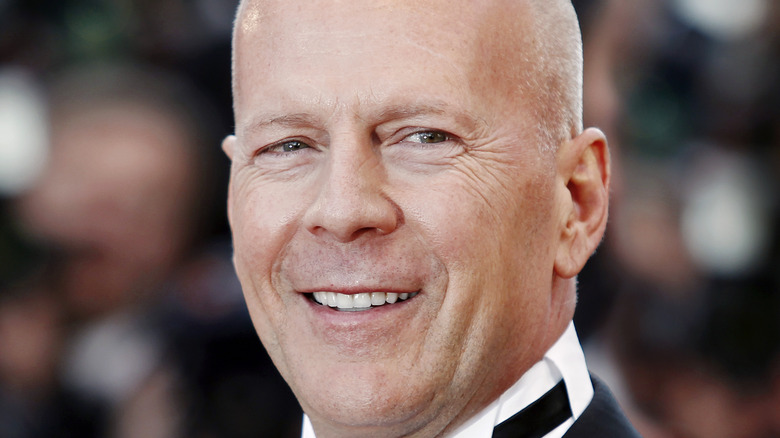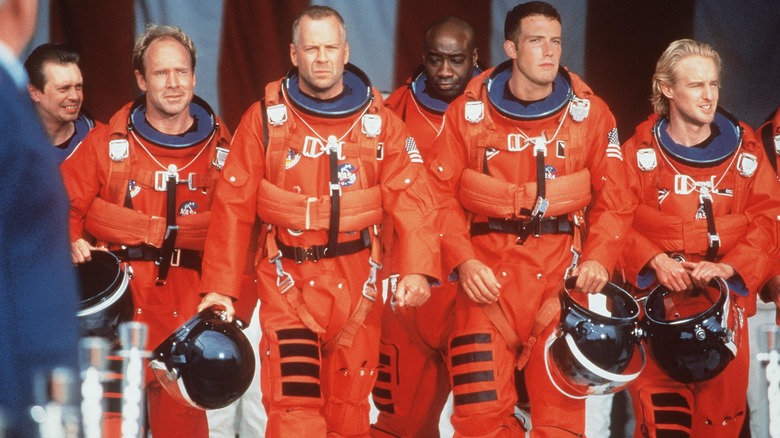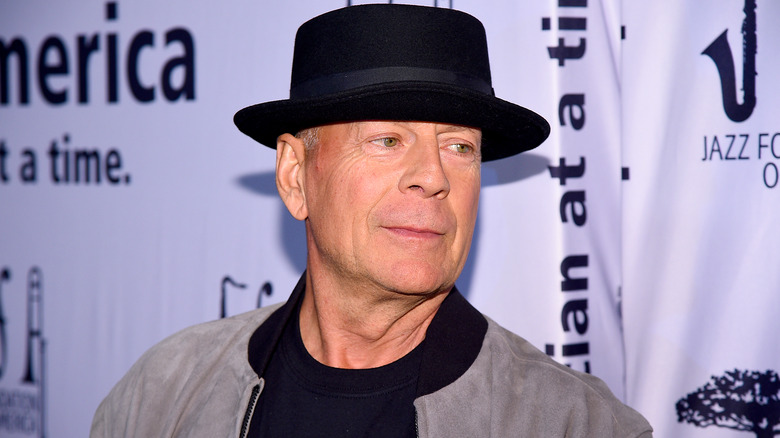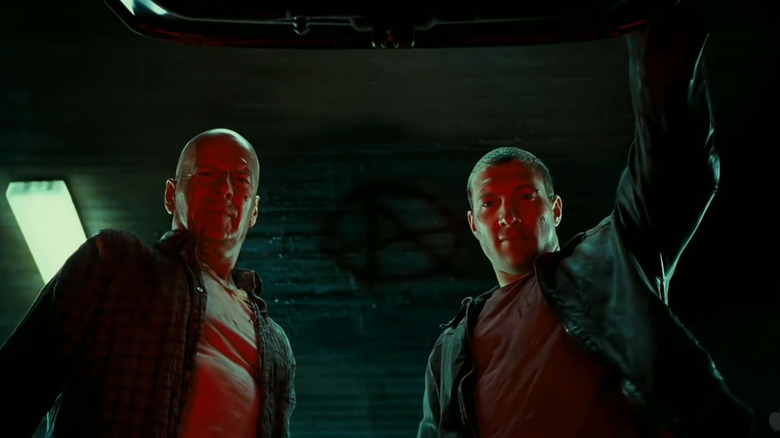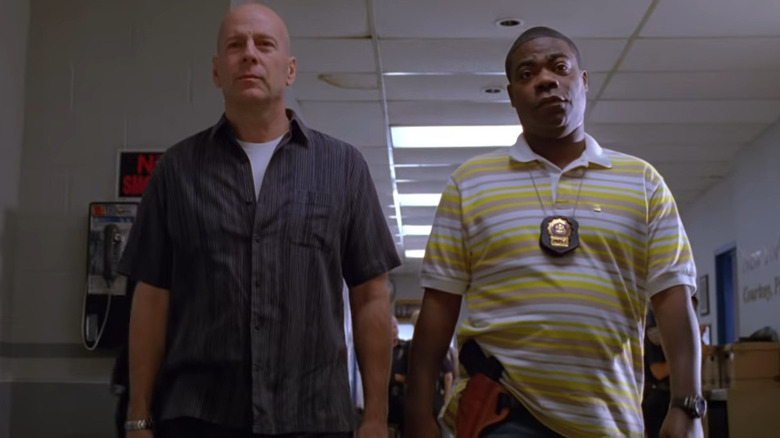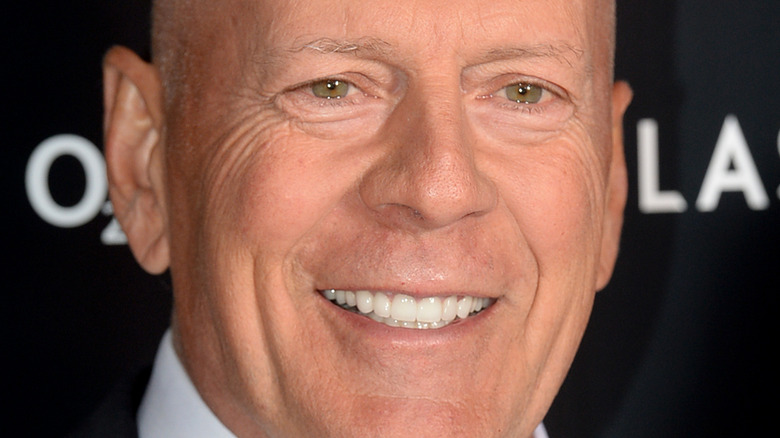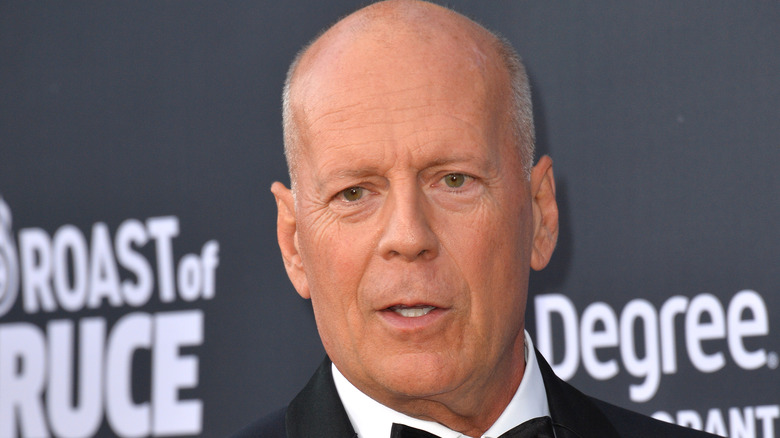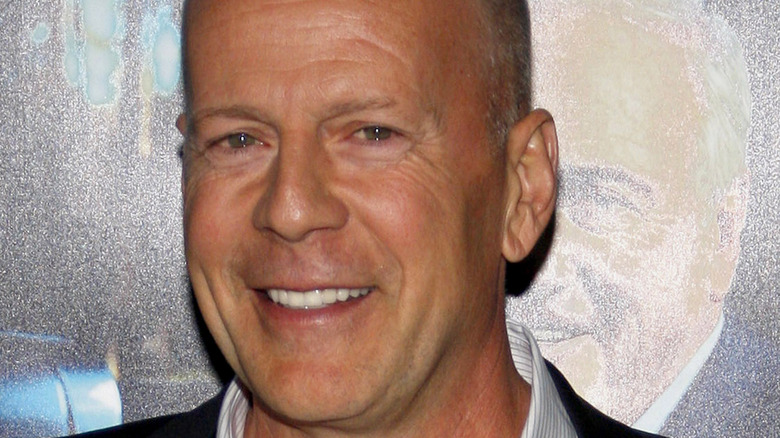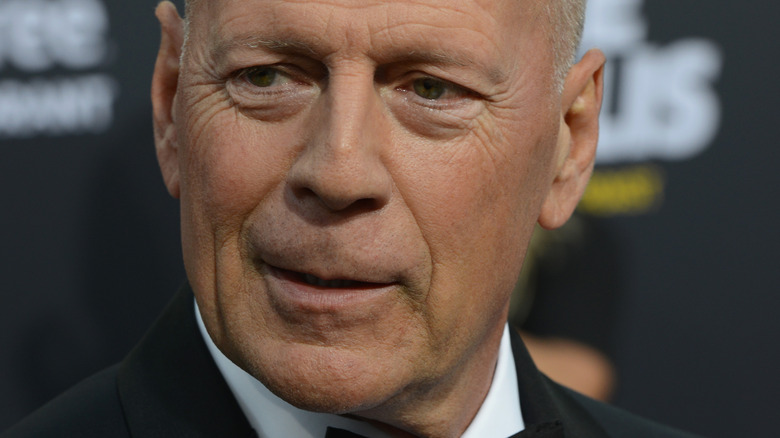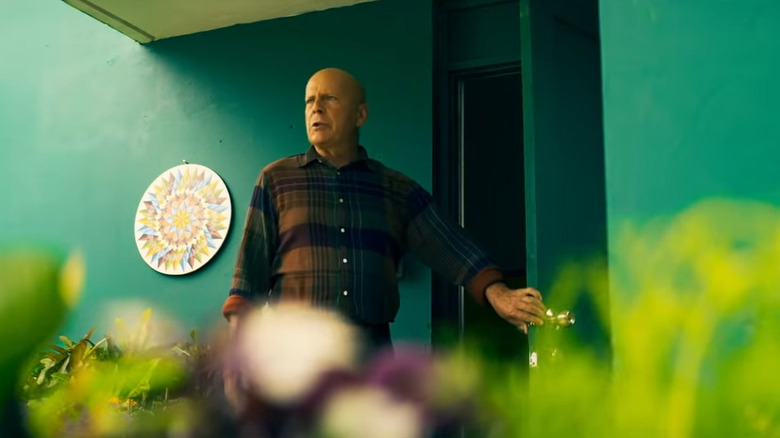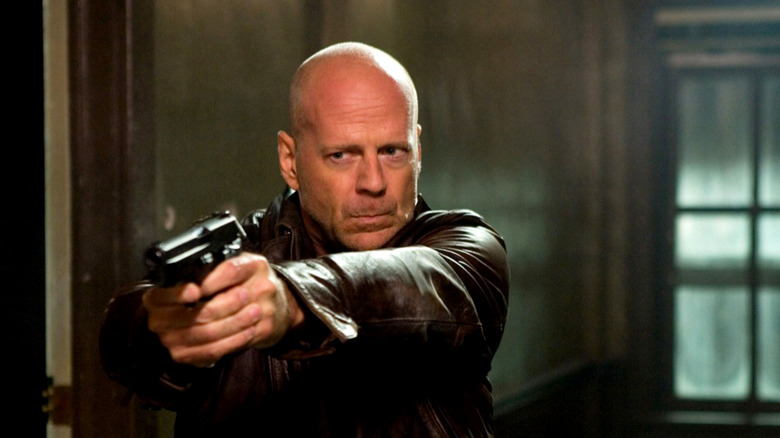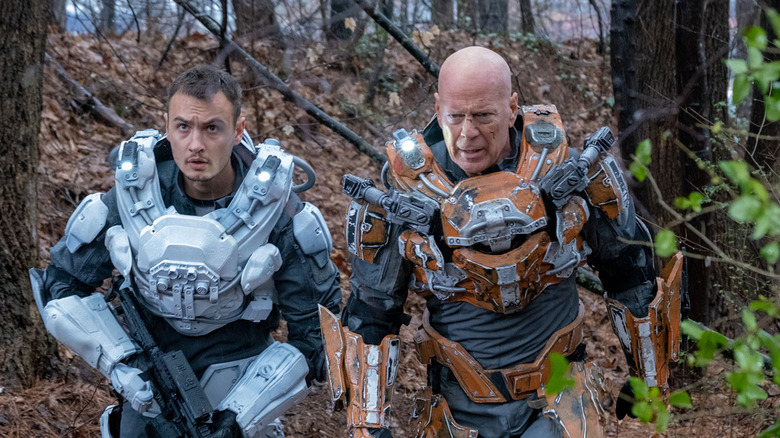From Action Superstar To Tragic Retirement: Inside Bruce Willis' Final Years Of Acting
Bruce Willis. That name is bound to conjure up different images for different people. If you're a 1980s kid like filmmaker Barry Jenkins, you probably know him best from "Die Hard." Others, though, have grown a fondness for his comedic works, while still others may be partial to his forays into critically-acclaimed dramas like "Looper" or "Moonrise Kingdom." That said, the modern-day career of Willis is not known for delivering features on par with beloved titles like "Unbreakable." Instead, Willis has become associated with direct-to-video cinema, the kind of features that populate Redbox kiosks or ad-based streaming services. They're movies that have lots of bullets and cheesy one-liners, but rarely even the substance of the worst "Die Hard" installment.
The idea of Willis headlining such motion pictures after being the centerpiece of megahit movies like "Armageddon" may sound preposterous, but it's become a notable part of the modern-day pop culture landscape. Given the perplexing nature of this development, it's very reasonable to ask how Willis got here. Tracking the troubles Willis faced in his most recent theatrically-released star vehicles, not to mention breaking down the advantages to appear in direct-to-video movies, can help provide some clarity as to what happened to Bruce Willis — especially in light of his tragic retirement from acting.
The initial success of Bruce Willis
For decades, Bruce Willis wasn't just a big-name actor. He was one of the more reliable box office draws out there. Just look at his stretch of film credits from 1994 to 2000, when he managed to star in six separate films, five of them completely original projects, that all grossed north of $200 million worldwide. The fact that these productions varied greatly in genre, from science-fiction to thriller to action blockbuster, was a testament to the appeal that Willis had. Audiences were willing to follow him nearly everywhere, especially when he was reprising his "Die Hard" role of John McClane.
His financial credibility continued into the 21st-century, when he began to play on people's nostalgia for his 1980s works. This fueled the box office success of productions like "Live Free or Die Hard." Even into the 2010s, Willis was still headlining lucrative projects like "Looper" and "Red," giving him further hits roughly 25 years after his first leading man role in a movie, "Blind Date." All in all, the combined worldwide box office grosses of Willis' films has tallied well over $6.7 billion. This sum puts him ahead of other famous lead actors such as Liam Neeson, Hugh Jackman, and Jennifer Lawrence, among many others. If one were going by his box office prowess for decades, it would seem inconceivable that Willis would ever be caught in the mire of direct-to-video cinema.
Bruce Willis' first forays into DTV movies
Not every movie Willis has appeared in has become a box office hit. Even the man responsible for launching the "Die Hard" movies is capable of appearing in notorious duds like "North." However, one constant throughout his career was that his features always went to theaters. If you wanted to see a new Willis star vehicle, you'd have to travel to the big screen to see it. Even his one pre-2010 direct-to-video acting credit reflected this tendency: The 2009 indie film "Assassination of a High School President" featured Willis in a supporting role and was supposed to go to theaters courtesy of the Yari Film Group. However, once that studio went bankrupt, it was sent to home video courtesy of Sony Entertainment.
However, in 2011, Willis first appeared in a motion picture designed for the small screen with the action/thriller "Setup." This also established another key element of this phase of Willis' career: his relationship with the production company Emmet/Furla Films. This outfit would have some level of involvement in many of Willis' subsequent direct-to-video endeavors. That same year, Willis further dipped his toes into these waters with "Catch .44." His presence in this particular project inspired incredulous responses from the internet, expressing surprise Willis would appear in such low-budget fare. What was a shock in 2011, though, would soon become the norm for Willis' career.
Theatrical box office struggles for Bruce Willis
Bruce Willis has never been able to avoid box office bombs, as titles like "Hudson Hawk" can attest. However, in 2013, Willis experienced two especially notable disappointments in the form of "Red 2" and "A Good Day to Die Hard." The latter title wasn't exactly a wipeout, since it made $304.2 million worldwide on a $92 million budget. However, it hit a new box office low for the "Die Hard" saga in North America and also made less than its two direct predecessors at the international box office. "Red 2", meanwhile, made considerably less than its predecessor and failed to crack $150 million globally. With these discouraging financial developments, a new franchise was stopped dead in its tracks.
The comparative failure of these two 2013 titles was especially distressing since, unlike past Willis box office duds like "Surrogates," both of these tentpoles were part of supposedly bulletproof franchises. If Willis could no longer be relied on to draw in moviegoers within the confines of sequels, that was a major problem. The fact that these two projects were following up other then-recent Willis box office non-starters like "Cop Out" only rubbed further salt in these wounds. While not the sole reason he embraced DTV releases, the box office woes Willis experienced in 2013 reflected his diminishing returns as a big-screen draw. It was inevitable, then, that he'd look for alternative places to continue his leading man career.
Diminishing presence of mid-budget theatrical features
Bruce Willis has started in several massively expensive blockbusters like the "Die Hard" sequels and "Armageddon." However, he's primarily headlined mid-budget action, comedy, and thriller vehicles. As late as the 2010s, Willis was still showing up in theatrical releases like "Cop Out" or "The Cold Light of Day" that didn't carry massive costs and weren't based on pre-existing properties. Even the 2010 hit "Red," though technically a DC Comics adaptation, was made in these confines thanks to its $58 million budget.
However, his opportunities to appear in such projects began to dwindle as the 2010s went on and major theatrical movie studios began to shift away from mid-budget projects. Studios like Warner Bros. were now interested in launching long-term cinematic universes, not the sort of one-off hits that Willis had consistently spun into gold in years past. This seismic alteration in Hollywood was best reflected by how 20th Century Fox, the outfit behind Willis' "Die Hard" movies, was absorbed into Disney in 2019, thus depriving the world of another source for original mid-budget fare. With fewer and fewer opportunities to show up in titles of the scale of "16 Blocks" in theaters, it's easy to imagine that the age of direct to video cinema would suddenly look a lot more appealing to Willis. Like many other older actors, Willis has had to find alternative routes to headlining projects as Hollywood shifts its priorities around.
Willis' struggles to maintain mainstream gigs
In 2015, Bruce Willis secured a very impressive acting gig: a supporting role in the Woody Allen movie "Café Society." Pairing up this performer with Jesse Eisenberg and Kristen Stewart, Willis was set to play Eisenberg's boss who becomes embroiled in a love triangle that involves Stewart's character. Not only was Willis signed on for the role, but set photos emerged showing him filming scenes in a vintage automobile with Eisenberg. Willis, it appeared, had secured another high-profile arthouse gig.
Unfortunately, a few days into principal photography, the "Café Society" production made the sudden announcement that Willis would no longer be a part of the feature. The announced reason for his departure was a scheduling conflict with a new Broadway take on "Misery" that Willis was supposed to headline. However, rumors swirled that Willis had been let go after having difficulty memorizing his lines, a problem that produced a strain for the other actors.
(It's worth noting that, after Willis' aphasia diagnosis was made public, a source told Page Six that Willis was having "cognitive problems" for years and occasionally had his lines fed to him through an earpiece. Another source corroborated these statements to The Sun, who also pointed out that "The changes became noticeable about five years ago" — which is around the same time "Café Society" was in production.)
While this disruption didn't single-handedly kill his career, Willis' inability to stick around for "Café Society" — not to mention his then-recent spat with Sylvester Stallone, which led to his character getting written out of "The Expendables 3" – speak to his difficulty in the 2010s on maintaining consistent mainstream work. Direct-to-video movies weren't just an easy paycheck, they were also a fallback now that Willis was struggling to secure steady theatrical movie gigs.
Embracing DTV gigs
When moviegoers sat down in theaters to see "Sin City: A Dame to Kill For," few could've imagined that this was one of the last theatrical releases Willis would appear in for years. Save for a brief appearance in the 2015 Barry Levinson feature "Rock the Kasbah" and the 2017 M. Night Shyamalan thriller "Split," Willis would spend the next four years exclusively embracing direct-to-video cinema. Instead, 2015 titles like "Vice" and "Extraction" set the mold for the kind of features that Willis would begin cranking out constantly in the years to come.
Many of this movies were action or thriller flicks, ones that featured Willis in a prominent capacity on their posters that didn't reflect his screentime. 2016 would further cement his commitment to this type of cinema while a movie from that year, "Precious Cargo," took the actor to new lows in terms of general critical reception. While critics were jeering, Willis only got more involved with these direct-to-video projects as the years go by. While he only headlined two straight-to-video features in 2016, Willis found time to anchor eight of these types of movies in 2020.
Examples of Willis' DTV movies
Given the obscure nature of Bruce Willis' direct-to-video efforts, it can be understandable if some aren't familiar with most (or even any) of the titles he's appeared in since 2014. Many of these productions hail from Emmett/Furla Productions and are typically oriented around thrills or action. A key example of this is "Midnight in the Switchgrass" from July 2021, which saw Willis sharing the stage with Megan Fox and Machine Gun Kelly in a detective yarn. Reviews were especially not kind for this project, with Willis receiving widespread criticism for his glazed-over performance.
Further examples of Bruce Willis' direct-to-video include "First Kill," a 2017 motion picture that teamed this man up with Hayden Christensen, "Cosmic Sin," a sci-fi adventure film that saw Willis joining forces with Frank Grillo, and "10 Minutes Gone," a 2019 crime drama pairing Willis up with Michael Chiklis. The presence of other notable names is key here, as these productions often involve Willis for only short bursts of screentime. The likes of Chiklis or other actors like Neal McDonough or Devon Sawa are often more of the protagonists than the marketing will let on. It's a bait-and-switch tactic that these direct-to-video titles have stuck to, no matter how much criticism previous works receive. That leads to another common trait among these projects: terrible reviews. Even by the standards of direct-to-video action schlock, Willis' forays into this territory often get dismal marks from critics.
The quick shooting schedules of DTV movies
A 2021 Vulture piece on producer Randall Emmett not only shed some light on this man's filmmaking endeavors, but also provided some clarity on why Bruce Willis kept appearing in these direct-to-video movies. Specifically, it's mentioned that many of the features Willis has appeared in involved roles that the actor spent only a handful of days or even a single afternoon filming. The quick turnaround time, in theory, provided a win-win scenario for all. Willis could get the work done quickly while the producers could have a big name to put on the movie's poster.
This method of filming also allowed Willis to do many direct-to-video titles in a single year. After all, when it takes just a handful of days to take care of these performances, it becomes a lot easier to cram multiple turns in one year. Compare that to the lengthy shooting schedules of Willis' earlier films, which often limited how many features Willis could headline in a single year. On "Unbreakable," for example, M. Night Shyamalan would engage in meticulous and time-consuming efforts to get each shot perfectly right. The lengthy time spent on principal photography on such features is like something from a different planet compared to the shooting schedules of Willis' direct-to-video titles.
Willis' creative control in low-budget confines
Bruce Willis seldom does press or interviews for his direct to video movies. Therefore, it's difficult to ask him questions regarding what drew him to projects like "Midnight in the Switchgrass." However, a MovieJawn interview with "Cosmic Sin" director Edward Blake does lend some potential insight into why Willis has become enamored with direct-to-video cinema.
In this interview, Blake reflects on the circumstances that led to Willis appearing in "Cosmic Sin." As it turns out, the duo had worked together before. Blake had previously gotten a call to write an earlier movie called "Anti-Life," later renamed "Breach." The project's entire existence was predicated solely on Willis wanting to do a sci-fi movie. While Willis has been able to exert creative control in his theatrical movie endeavors, it's doubtful he could just will a sci-fi movie into existence in a matter of days like this. Plus, this actor has often been rumored or alleged to want greater creative control on the projects he headlines, including productions ranging from "Moonlighting" to "Cop Out." Within the confines of direct-to-video movies, Willis can finally get his wish and exert considerably more influence as a creative participant.
The influence of multi-movie contracts
Part of why you've seen so many direct-to-video Bruce Willis movies lately isn't just because the actor's desperate for money or loves the scripts he's handed. Many of these projects exist solely because of contractual obligations. In recent years, Willis has signed multiple contracts with production companies to appear in a certain number of movies in a short period. One of the earliest major instances of this came about in 2018 when Willis agreed to show up in multiple Emmett/Furla movies. A little over two years later, Willis would re-up his contract with this production outfit for further feature-length endeavors, ensuring that Willis wasn't going anywhere from direct-to-video territory anytime soon.
This means there's a mandatory nature to Willis' appearances in these features. It's not inconceivable that his commitments to these multi-movie contracts are enough to keep him tied up even when theatrical movie releases (which have significantly longer shooting and promotional schedule commitments) offer him a potential role. With these deals in play, the long-term nature of Willis' commitment to direct-to-video action films becomes a lot clearer.
Bruce Willis hasn't totally abandoned theatrical movies
Though direct-to-video movies have dominated Bruce Willis' post-2013 career, he still managed to appear in a handful of theatrical movies. In 2018, Willis returned to starring in big-screen action fare with the Eli Roth-directed remake of "Death Wish." The film's marketing leaned into the idea of this being Willis' first theatrical star vehicle in a while by staging this project as a comeback for Willis, with "Death Wish" posters even flouting the tagline "Bruce is back." Unfortunately, the eventual $48.5 million worldwide gross of "Death Wish" was far from a rousing return to the glory days of Willis' box office prowess.
Meanwhile, in 2019, Willis appeared in a trio of theatrical releases, each varying greatly in terms of screentime. He was one of the lead characters of "Glass," a sequel to his 2000 film "Unbreakable." That thriller grossed $246.9 million worldwide, making it the 12th biggest title Willis has ever appeared in globally, a welcome departure from his box office blues in the 2010s. Willis also appeared in a cameo as himself in "The LEGO Movie 2: The Second Part" and also had a supporting role in Edward Norton's directorial effort "Motherless Brooklyn," the latter of which sank at the box office. Not all of these films were as big of moneymakers as "Armageddon," but the very presence of Willis in four theatrical films across 2018 and 2019 suggested that he hadn't entirely abandoned big-screen entertainment.
The future of Willis' DTV career, and his retirement
It's no secret that Bruce Willis regularly worked in direct-to-video cinema. As early as 2017, sites like Den of Geek were fascinated by how often Willis was going to this well for easy paychecks. A few years and countless direct-to-video Willis star vehicles later, this career downturn has become downright notorious. Everyone from The New York Times to pop culture writer Nathan Rabin has penned pieces exploring the shortcomings of these movies. This has often come with ruminations on why a man who used to headline gargantuan theatrical hits is diving headfirst into these films.
Even with his retirement from acting after being diagnosed with aphasia, he's still got plenty of upcoming perfectly made for Redbox kiosks. The IMDb page for Bruce Willis is littered with forthcoming features that will be sent directly to the small screen. Upcoming adventures include a pairing with Michael Rooker in called "Corrective Measures," which will be one of the first original movies released on Tubi, while "Pulp Fiction" fans can prepare for Willis and John Travolta to reunite in "Paradise City." His lengthy list of upcoming direct-to-video star vehicles even includes a second sequel to the 2021 feature "Fortress."
The reasons leading to Willis' current career status are multifaceted and complicated, and his exact involvement with these features remains to be seen. But his direct-to-video movies will remain part of his legacy, alongside his blockbuster turns.
